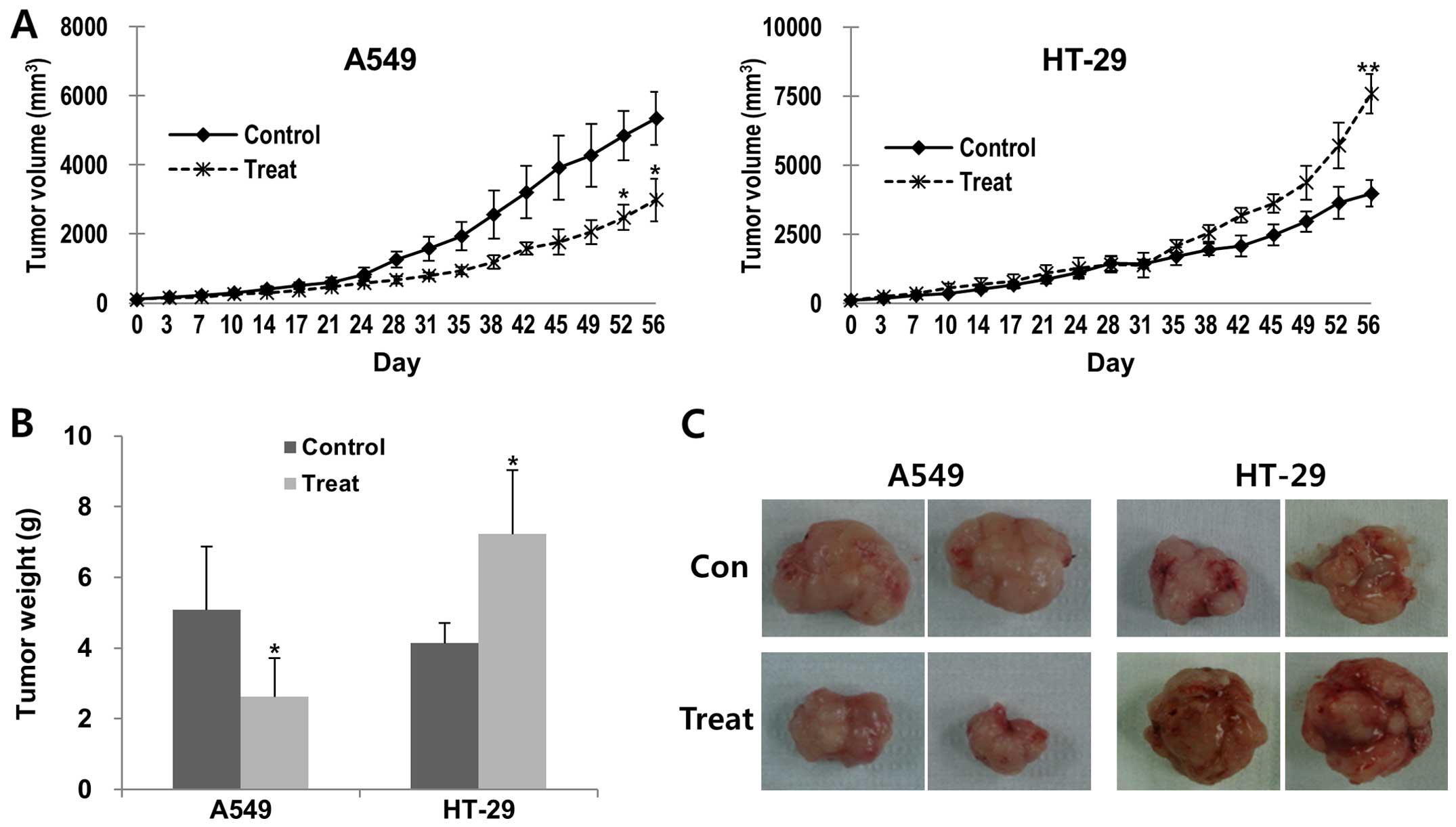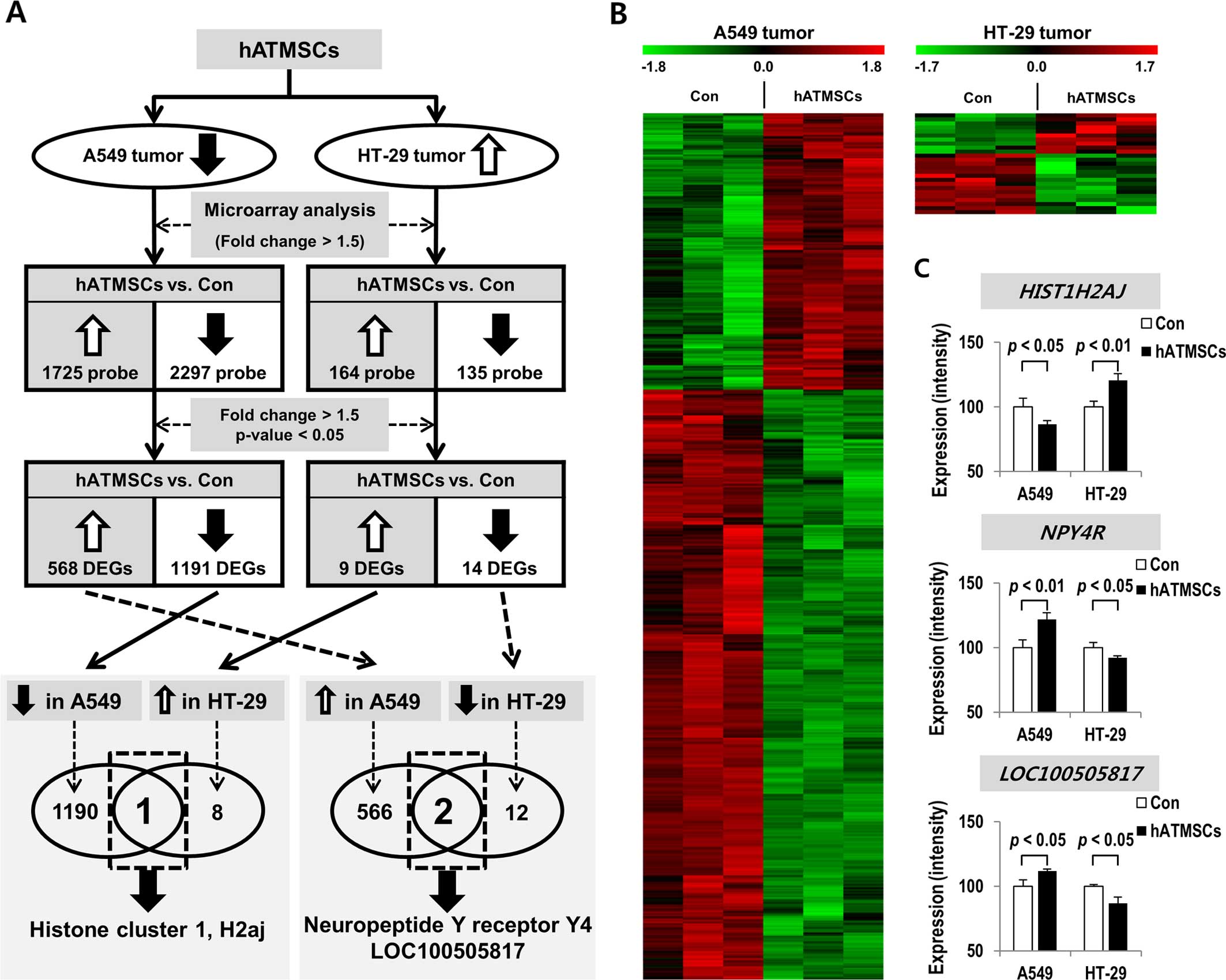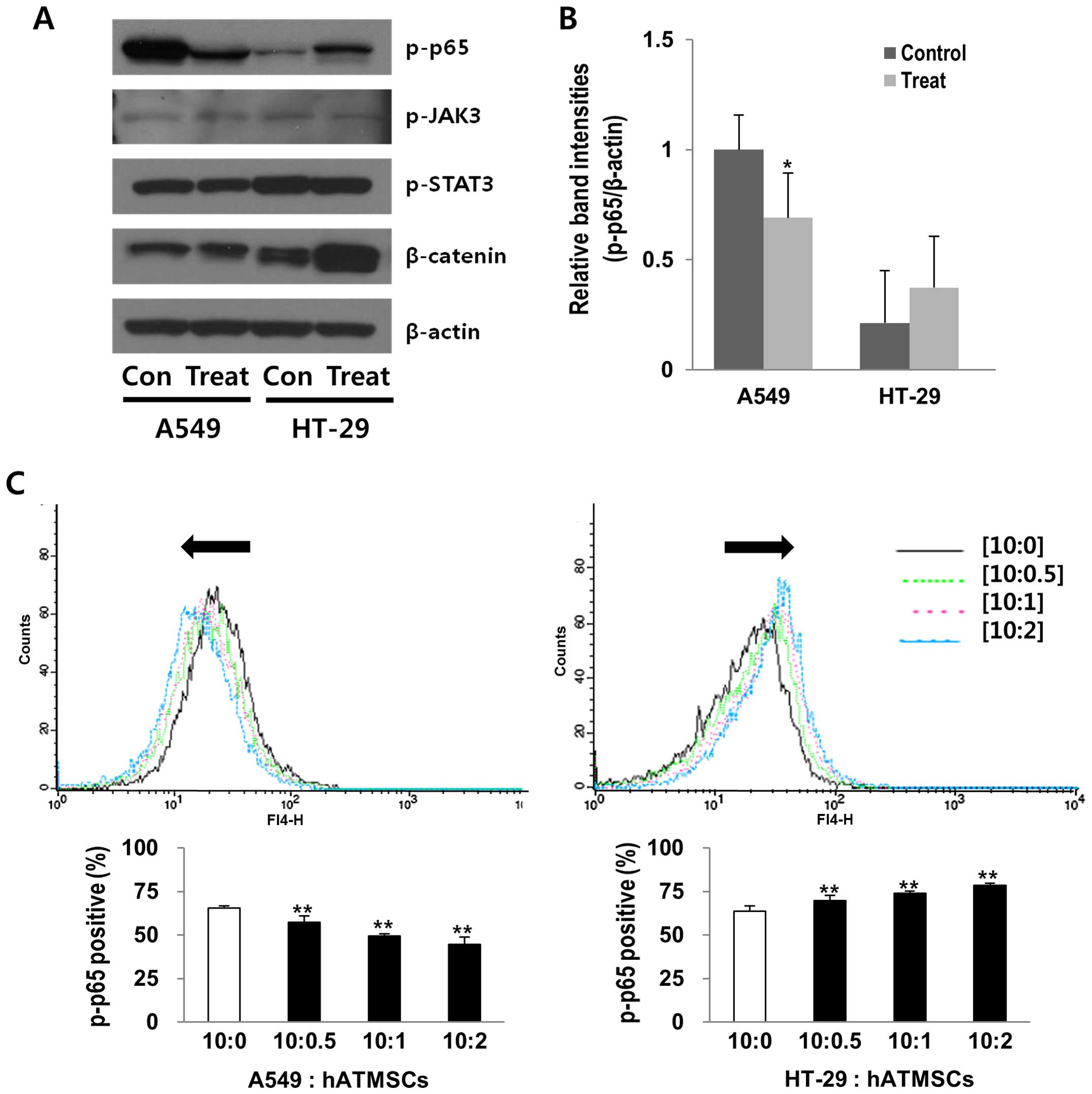|
1
|
Dominici M, Le Blanc K, Mueller I,
Slaper-Cortenbach I, Marini F, Krause D, Deans R, Keating A,
Prockop Dj and Horwitz E: Minimal criteria for defining multipotent
mesenchymal stromal cells. The International Society for Cellular
Therapy position statement. Cytotherapy. 8:315–317. 2006.
View Article : Google Scholar : PubMed/NCBI
|
|
2
|
Dong J, Uemura T, Shirasaki Y and Tateishi
T: Promotion of bone formation using highly pure porous beta-TCP
combined with bone marrow-derived osteoprogenitor cells.
Biomaterials. 23:4493–4502. 2002. View Article : Google Scholar : PubMed/NCBI
|
|
3
|
Choi HJ, Kim JM, Kwon E, Che JH, Lee JI,
Cho SR, Kang SK, Ra JC and Kang BC: Establishment of efficacy and
safety assessment of human adipose tissue-derived mesenchymal stem
cells (hATMSCs) in a nude rat femoral segmental defect model. J
Korean Med Sci. 26:482–491. 2011. View Article : Google Scholar : PubMed/NCBI
|
|
4
|
Toyoshima KE, Asakawa K, Ishibashi N, Toki
H, Ogawa M, Hasegawa T, Irié T, Tachikawa T, Sato A, Takeda A, et
al: Fully functional hair follicle regeneration through the
rearrangement of stem cells and their niches. Nat Commun.
3:7842012. View Article : Google Scholar : PubMed/NCBI
|
|
5
|
Seo KW, Sohn SY, Bhang DH, Nam MJ, Lee HW
and Youn HY: Therapeutic effects of hepatocyte growth
factor-overexpressing human umbilical cord blood-derived
mesenchymal stem cells on liver fibrosis in rats. Cell Biol Int.
38:106–116. 2014. View Article : Google Scholar
|
|
6
|
Perez-Basterrechea M, Obaya AJ, Meana A,
Otero J and Esteban MM: Cooperation by fibroblasts and bone
marrow-mesenchymal stem cells to improve pancreatic rat-to-mouse
islet xenotransplantation. PLoS One. 8:e735262013. View Article : Google Scholar : PubMed/NCBI
|
|
7
|
Bas E, Van De Water TR, Lumbreras V,
Rajguru S, Goss G, Hare JM and Goldstein BJ: Adult human nasal
mesenchymal-like stem cells restore cochlear spiral ganglion
neurons after experimental lesion. Stem Cells Dev. 23:502–514.
2014. View Article : Google Scholar :
|
|
8
|
Tian LL, Yue W, Zhu F, Li S and Li W:
Human mesenchymal stem cells play a dual role on tumor cell growth
in vitro and in vivo. J Cell Physiol. 226:1860–1867. 2011.
View Article : Google Scholar : PubMed/NCBI
|
|
9
|
Ra JC, Shin IS, Kim SH, Kang SK, Kang BC,
Lee HY, Kim YJ, Jo JY, Yoon EJ, Choi HJ, et al: Safety of
intravenous infusion of human adipose tissue-derived mesenchymal
stem cells in animals and humans. Stem Cells Dev. 20:1297–1308.
2011. View Article : Google Scholar : PubMed/NCBI
|
|
10
|
MacIsaac ZM, Shang H, Agrawal H, Yang N,
Parker A and Katz AJ: Long-term in-vivo tumorigenic assessment of
human culture-expanded adipose stromal/stem cells. Exp Cell Res.
318:416–423. 2012. View Article : Google Scholar :
|
|
11
|
Klopp AH, Gupta A, Spaeth E, Andreeff M
and Marini F III: Concise review: Dissecting a discrepancy in the
literature: do mesenchymal stem cells support or suppress tumor
growth? Stem Cells. 29:11–19. 2011. View
Article : Google Scholar : PubMed/NCBI
|
|
12
|
Maestroni GJ, Hertens E and Galli P:
Factor(s) from nonmacrophage bone marrow stromal cells inhibit
Lewis lung carcinoma and B16 melanoma growth in mice. Cell Mol Life
Sci. 55:663–667. 1999. View Article : Google Scholar : PubMed/NCBI
|
|
13
|
Khakoo AY, Pati S, Anderson SA, Reid W,
Elshal MF, Rovira II, Nguyen AT, Malide D, Combs CA, Hall G, et al:
Human mesenchymal stem cells exert potent antitumorigenic effects
in a model of Kaposi's sarcoma. J Exp Med. 203:1235–1247. 2006.
View Article : Google Scholar : PubMed/NCBI
|
|
14
|
Li L, Tian H, Chen Z, Yue W, Li S and Li
W: Inhibition of lung cancer cell proliferation mediated by human
mesenchymal stem cells. Acta Biochim Biophys Sin. 43:143–148. 2011.
View Article : Google Scholar : PubMed/NCBI
|
|
15
|
Zhu W, Xu W, Jiang R, Qian H, Chen M, Hu
J, Cao W, Han C and Chen Y: Mesenchymal stem cells derived from
bone marrow favor tumor cell growth in vivo. Exp Mol Pathol.
80:267–274. 2006. View Article : Google Scholar
|
|
16
|
Xu WT, Bian ZY, Fan QM, Li G and Tang TT:
Human mesenchymal stem cells (hMSCs) target osteosarcoma and
promote its growth and pulmonary metastasis. Cancer Lett.
281:32–41. 2009. View Article : Google Scholar : PubMed/NCBI
|
|
17
|
Tsai KS, Yang SH, Lei YP, Tsai CC, Chen
HW, Hsu CY, Chen LL, Wang HW, Miller SA, Chiou SH, et al:
Mesenchymal stem cells promote formation of colorectal tumors in
mice. Gastroenterology. 141:1046–1056. 2011. View Article : Google Scholar : PubMed/NCBI
|
|
18
|
Roorda BD, ter Elst A, Kamps WA and de
Bont ES: Bone marrow-derived cells and tumor growth: Contribution
of bone marrow-derived cells to tumor microenvironments with
special focus on mesenchymal stem cells. Crit Rev Oncol Hematol.
69:187–198. 2009. View Article : Google Scholar
|
|
19
|
Mishra PJ, Mishra PJ, Humeniuk R, Medina
DJ, Alexe G, Mesirov JP, Ganesan S, Glod JW and Banerjee D:
Carcinoma-associated fibroblast-like differentiation of human
mesenchymal stem cells. Cancer Res. 68:4331–4339. 2008. View Article : Google Scholar : PubMed/NCBI
|
|
20
|
Plumas J, Chaperot L, Richard MJ, Molens
JP, Bensa JC and Favrot MC: Mesenchymal stem cells induce apoptosis
of activated T cells. Leukemia. 19:1597–1604. 2005. View Article : Google Scholar : PubMed/NCBI
|
|
21
|
Karnoub AE, Dash AB, Vo AP, Sullivan A,
Brooks MW, Bell GW, Richardson AL, Polyak K, Tubo R and Weinberg
RA: Mesenchymal stem cells within tumour stroma promote breast
cancer metastasis. Nature. 449:557–563. 2007. View Article : Google Scholar : PubMed/NCBI
|
|
22
|
Lu YR, Yuan Y, Wang XJ, Wei LL, Chen YN,
Cong C, Li SF, Long D, Tan WD, Mao YQ, et al: The growth inhibitory
effect of mesenchymal stem cells on tumor cells in vitro and in
vivo. Cancer Biol Ther. 7:245–251. 2008. View Article : Google Scholar
|
|
23
|
Otsu K, Das S, Houser SD, Quadri SK,
Bhattacharya S and Bhattacharya J: Concentration-dependent
inhibition of angiogenesis by mesenchymal stem cells. Blood.
113:4197–4205. 2009. View Article : Google Scholar :
|
|
24
|
Qiao L, Xu ZL, Zhao TJ, Ye LH and Zhang
XD: Dkk-1 secreted by mesenchymal stem cells inhibits growth of
breast cancer cells via depression of Wnt signalling. Cancer Lett.
269:67–77. 2008. View Article : Google Scholar : PubMed/NCBI
|
|
25
|
Kubota T, Yamaguchi H, Watanabe M,
Yamamoto T, Takahara T, Takeuchi T, Furukawa T, Kase S, Kodaira S,
Ishibiki K, et al: Growth of human tumor xenografts in nude mice
and mice with severe combined immunodeficiency (SCID). Surg Today.
23:375–377. 1993. View Article : Google Scholar : PubMed/NCBI
|
|
26
|
Denicolaï E, Baeza-Kallee N, Tchoghandjian
A, Carré M, Colin C, Jiglaire CJ, Mercurio S, Beclin C and
Figarella-Branger D: Proscillaridin A is cytotoxic for glioblastoma
cell lines and controls tumor xenograft growth in vivo. Oncotarget.
5:10934–10948. 2014.PubMed/NCBI
|
|
27
|
Yun JW, Lee TR, Kim CW, Park YH, Chung JH,
Lee YS, Kang KS and Lim KM: Predose blood gene expression profiles
might identify the individuals susceptible to carbon
tetrachloride-induced hepatotoxicity. Toxicol Sci. 115:12–21. 2010.
View Article : Google Scholar : PubMed/NCBI
|
|
28
|
Jung KW, Won YJ, Kong HJ, Oh CM, Seo HG
and Lee JS: Prediction of cancer incidence and mortality in Korea,
2013. Cancer Res Treat. 45:15–21. 2013. View Article : Google Scholar : PubMed/NCBI
|
|
29
|
Paine-Murrieta GD, Taylor CW, Curtis RA,
Lopez MH, Dorr RT, Johnson CS, Funk CY, Thompson F and Hersh EM:
Human tumor models in the severe combined immune deficient (scid)
mouse. Cancer Chemother Pharmacol. 40:209–214. 1997. View Article : Google Scholar : PubMed/NCBI
|
|
30
|
Hao Y, Huang W, Liao M, Zhu Y, Liu H, Hao
C, Liu G, Zhang G, Feng H, Ning X, et al: The inhibition of
resveratrol to human skin squamous cell carcinoma A431 xenografts
in nude mice. Fitoterapia. 86:84–91. 2013. View Article : Google Scholar : PubMed/NCBI
|
|
31
|
Ansari D, Bauden MP, Sasor A, Gundewar C
and Andersson R: Analysis of MUC4 expression in human pancreatic
cancer xenografts in immunodeficient mice. Anticancer Res.
34:3905–3910. 2014.PubMed/NCBI
|
|
32
|
Uchibori R, Tsukahara T, Mizuguchi H, Saga
Y, Urabe M, Mizukami H, Kume A and Ozawa K: NF-κB activity
regulates mesenchymal stem cell accumulation at tumor sites. Cancer
Res. 73:364–372. 2013. View Article : Google Scholar
|
|
33
|
Kéramidas M, de Fraipont F, Karageorgis A,
Moisan A, Persoons V, Richard MJ, Coll JL and Rome C: The dual
effect of mesenchymal stem cells on tumour growth and tumour
angiogenesis. Stem Cell Res Ther. 4:412013. View Article : Google Scholar : PubMed/NCBI
|
|
34
|
Fierro FA, Sierralta WD, Epuñan MJ and
Minguell JJ: Marrow-derived mesenchymal stem cells: Role in
epithelial tumor cell determination. Clin Exp Metastasis.
21:313–319. 2004. View Article : Google Scholar : PubMed/NCBI
|
|
35
|
Potapova IA, Gaudette GR, Brink PR,
Robinson RB, Rosen MR, Cohen IS and Doronin SV: Mesenchymal stem
cells support migration, extracellular matrix invasion,
proliferation, and survival of endothelial cells in vitro. Stem
Cells. 25:1761–1768. 2007. View Article : Google Scholar : PubMed/NCBI
|
|
36
|
Qiao L, Xu Z, Zhao T, Zhao Z, Shi M, Zhao
RC, Ye L and Zhang X: Suppression of tumorigenesis by human
mesenchymal stem cells in a hepatoma model. Cell Res. 18:500–507.
2008. View Article : Google Scholar : PubMed/NCBI
|
|
37
|
Abdel aziz MT, El Asmar MF, Atta HM,
Mahfouz S, Fouad HH, Roshdy NK, Rashed LA, Sabry D, Hassouna AA and
Taha FM: Efficacy of mesenchymal stem cells in suppression of
hepatocarcinorigenesis in rats: Possible role of Wnt signaling. J
Exp Clin Cancer Res. 30:492011. View Article : Google Scholar : PubMed/NCBI
|
|
38
|
Kim BY, Lee J, Park SJ, Bang OS and Kim
NS: Gene expression profile of the A549 human non-small cell lung
carcinoma cell line following treatment with the seeds of
Descurainia sophia, a potential anticancer drug. Evid Based
Complement Alternat Med. 2013:5846042013.PubMed/NCBI
|
|
39
|
Creighton C, Kuick R, Misek DE, Rickman
DS, Brichory FM, Rouillard JM, Omenn GS and Hanash S: Profiling of
pathway-specific changes in gene expression following growth of
human cancer cell lines transplanted into mice. Genome Biol.
4:R462003. View Article : Google Scholar : PubMed/NCBI
|
|
40
|
Lu C, Xiong M, Luo Y, Li J, Zhang Y, Dong
Y, Zhu Y, Niu T, Wang Z and Duan L: Genome-wide transcriptional
analysis of apoptosis-related genes and pathways regulated by H2AX
in lung cancer A549 cells. Apoptosis. 18:1039–1047. 2013.
View Article : Google Scholar : PubMed/NCBI
|
|
41
|
Lo FY, Chang JW, Chang IS, Chen YJ, Hsu
HS, Huang SF, Tsai FY, Jiang SS, Kanteti R, Nandi S, et al: The
database of chromosome imbalance regions and genes resided in lung
cancer from Asian and Caucasian identified by array-comparative
genomic hybridization. BMC Cancer. 12:2352012. View Article : Google Scholar : PubMed/NCBI
|
|
42
|
Yang B, Zhang J, Yin Y and Zhang Y:
Network-based inference framework for identifying cancer genes from
gene expression data. BioMed Res Int. 2013:4016492013. View Article : Google Scholar : PubMed/NCBI
|
|
43
|
Kavak E, Unlü M, Nistér M and Koman A:
Meta-analysis of cancer gene expression signatures reveals new
cancer genes, SAGE tags and tumor associated regions of
co-regulation. Nucleic Acids Res. 38:7008–7021. 2010. View Article : Google Scholar : PubMed/NCBI
|
|
44
|
Herzog H: Neuropeptide Y and energy
homeostasis: Insights from Y receptor knockout models. Eur J
Pharmacol. 480:21–29. 2003. View Article : Google Scholar : PubMed/NCBI
|
|
45
|
Renshaw D and Batterham RL: Peptide YY: A
potential therapy for obesity. Curr Drug Targets. 6:171–179. 2005.
View Article : Google Scholar : PubMed/NCBI
|
|
46
|
Huda MS, Wilding JP and Pinkney JH: Gut
peptides and the regulation of appetite. Obes Rev. 7:163–182. 2006.
View Article : Google Scholar : PubMed/NCBI
|
|
47
|
Zhang L, Bijker MS and Herzog H: The
neuropeptide Y system: Pathophysiological and therapeutic
implications in obesity and cancer. Pharmacol Ther. 131:91–113.
2011. View Article : Google Scholar : PubMed/NCBI
|
|
48
|
Ma Y, Hao X, Zhang S and Zhang J: The in
vitro and in vivo effects of human umbilical cord mesenchymal stem
cells on the growth of breast cancer cells. Breast Cancer Res
Treat. 133:473–485. 2012. View Article : Google Scholar
|
|
49
|
Escárcega RO, Fuentes-Alexandro S,
García-Carrasco M, Gatica A and Zamora A: The transcription factor
nuclear factor-kappa B and cancer. Clin Oncol. 19:154–161. 2007.
View Article : Google Scholar
|
|
50
|
Pikarsky E and Ben-Neriah Y: NF-kappaB
inhibition: A double-edged sword in cancer? Eur J Cancer.
42:779–784. 2006. View Article : Google Scholar : PubMed/NCBI
|
|
51
|
Zhang J, Xu YJ, Xiong WN, Zhang ZX, Du CL,
Qiao LF, Ni W and Chen SX: Inhibition of NF-kappaB through
IkappaBalpha transfection affects invasion of human lung cancer
cell line A549. Ai Zheng. 27:710–715. 2008.In Chinese. PubMed/NCBI
|
|
52
|
Kuliková L, Mikeš J, Hýžďalová M, Palumbo
G and Fedoročko P: NF-κB is not directly responsible for
photoresistance induced by fractionated light delivery in HT-29
colon adenocarcinoma cells. Photochem Photobiol. 86:1285–1293.
2010. View Article : Google Scholar
|



















